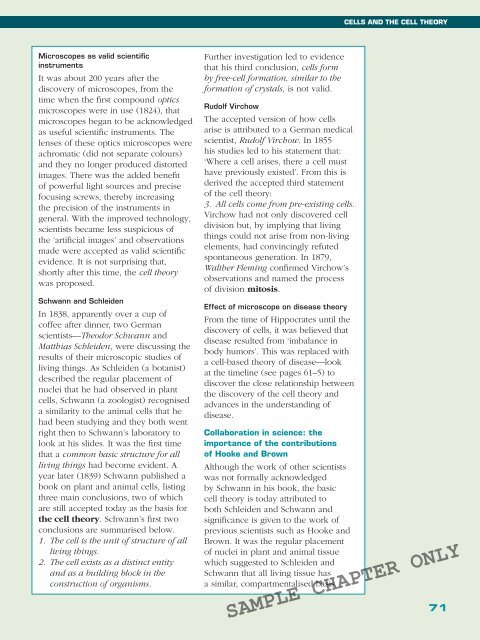BIOLOGY IN FOCUS
BIOLOGY IN FOCUS
BIOLOGY IN FOCUS
Create successful ePaper yourself
Turn your PDF publications into a flip-book with our unique Google optimized e-Paper software.
CELLS AND THE CELL THEORY<br />
Microscopes as valid scientific<br />
instruments<br />
It was about 200 years after the<br />
discovery of microscopes, from the<br />
time when the first compound optics<br />
microscopes were in use (1824), that<br />
microscopes began to be acknowledged<br />
as useful scientific instruments. The<br />
lenses of these optics microscopes were<br />
achromatic (did not separate colours)<br />
and they no longer produced distorted<br />
images. There was the added benefit<br />
of powerful light sources and precise<br />
focusing screws, thereby increasing<br />
the precision of the instruments in<br />
general. With the improved technology,<br />
scientists became less suspicious of<br />
the ‘artificial images’ and observations<br />
made were accepted as valid scientific<br />
evidence. It is not surprising that,<br />
shortly after this time, the cell theory<br />
was proposed.<br />
Schwann and Schleiden<br />
In 1838, apparently over a cup of<br />
coffee after dinner, two German<br />
scientists—Theodor Schwann and<br />
Matthias Schleiden, were discussing the<br />
results of their microscopic studies of<br />
living things. As Schleiden (a botanist)<br />
described the regular placement of<br />
nuclei that he had observed in plant<br />
cells, Schwann (a zoologist) recognised<br />
a similarity to the animal cells that he<br />
had been studying and they both went<br />
right then to Schwann’s laboratory to<br />
look at his slides. It was the first time<br />
that a common basic structure for all<br />
living things had become evident. A<br />
year later (1839) Schwann published a<br />
book on plant and animal cells, listing<br />
three main conclusions, two of which<br />
are still accepted today as the basis for<br />
the cell theory. Schwann’s first two<br />
conclusions are summarised below.<br />
1. The cell is the unit of structure of all<br />
living things.<br />
2. The cell exists as a distinct entity<br />
and as a building block in the<br />
construction of organisms.<br />
Further investigation led to evidence<br />
that his third conclusion, cells form<br />
by free-cell formation, similar to the<br />
formation of crystals, is not valid.<br />
Rudolf Virchow<br />
The accepted version of how cells<br />
arise is attributed to a German medical<br />
scientist, Rudolf Virchow. In 1855<br />
his studies led to his statement that:<br />
‘Where a cell arises, there a cell must<br />
have previously existed’. From this is<br />
derived the accepted third statement<br />
of the cell theory:<br />
3. All cells come from pre-existing cells.<br />
Virchow had not only discovered cell<br />
division but, by implying that living<br />
things could not arise from non-living<br />
elements, had convincingly refuted<br />
spontaneous generation. In 1879,<br />
Walther Fleming confirmed Virchow’s<br />
observations and named the process<br />
of division mitosis.<br />
Effect of microscope on disease theory<br />
From the time of Hippocrates until the<br />
discovery of cells, it was believed that<br />
disease resulted from ‘imbalance in<br />
body humors’. This was replaced with<br />
a cell-based theory of disease—look<br />
at the timeline (see pages 61–5) to<br />
discover the close relationship between<br />
the discovery of the cell theory and<br />
advances in the understanding of<br />
disease.<br />
Collaboration in science: the<br />
importance of the contributions<br />
of Hooke and Brown<br />
Although the work of other scientists<br />
was not formally acknowledged<br />
by Schwann in his book, the basic<br />
cell theory is today attributed to<br />
both Schleiden and Schwann and<br />
significance is given to the work of<br />
previous scientists such as Hooke and<br />
Brown. It was the regular placement<br />
of nuclei in plant and animal tissue<br />
which suggested to Schleiden and<br />
Schwann that all living tissue has<br />
a similar, compartmentalised basis.<br />
SAMPLE CHAPTER ONLY<br />
71
















